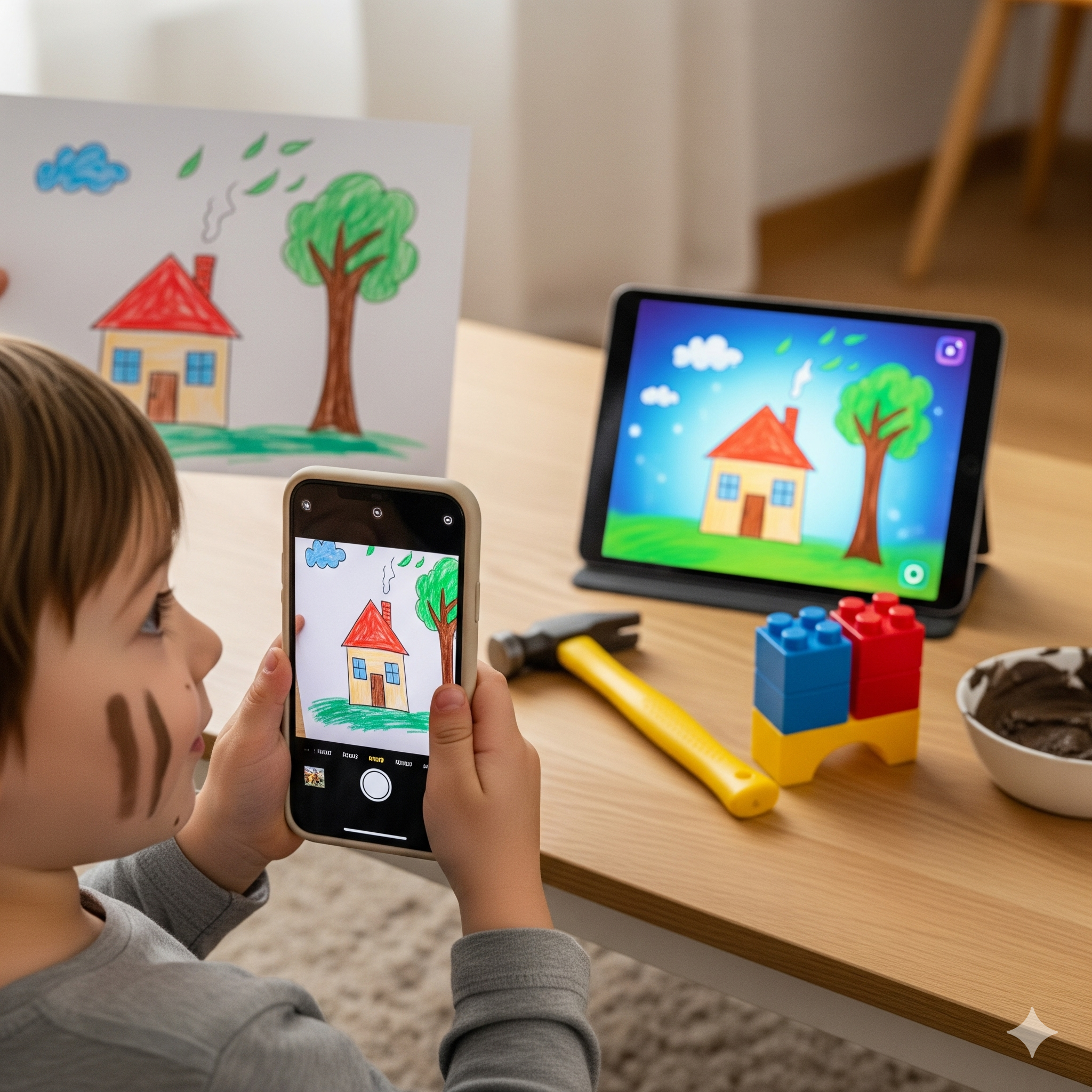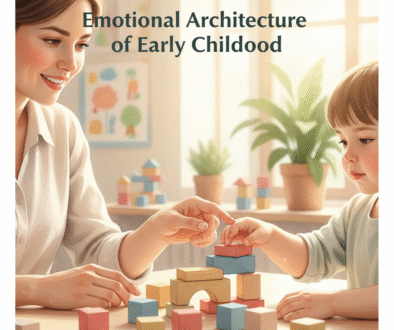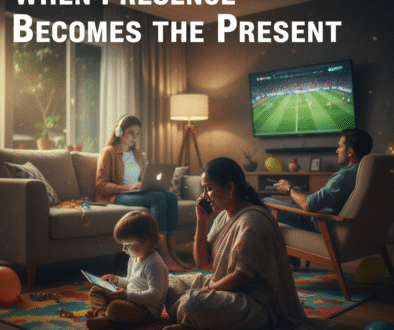Innowacje w edukacji wczesnoszkolnej: Rola sztucznej inteligencji w nauce i rozwoju opartym na zabawie.

Innowacyjność i inkluzywność: Sztuczna inteligencja we wczesnej edukacji
Sztuczna inteligencja we wczesnym dzieciństwie: Równoważenie technologii, zabłoconych butów i prawdziwej ludzkiej nauki
Zapomnij o wszystkim, co myślisz, że wiesz o Sztuczna inteligencja we wczesnej edukacji. Nie chodzi o ekrany i ciche dzieci. Chodzi o zabłocone buty i śmiech.
Prawda jest prosta: nie możemy głosować nad tym, czy technologia pojawi się w naszych klasach. Ona już tu jest. Sztuczna inteligencja nie czeka na nasze upodobania. Pytanie brzmi: jak zrównoważyć to z hałaśliwą, niechlujną magią wczesnego dzieciństwa?
Dzieciństwo, tak jak je widzę
Dla mnie doskonałość we wczesnych latach nie oznacza dziecka siedzącego cicho z tabletem. To:
- Zabłocone kolana od pluskania się w kałużach.
- Trzylatek wbijający gwoździe w chwiejący się domek dla ptaków.
- Dzieci gotujące na ogniu, siekające warzywa prawdziwymi nożami.
- Zamiatanie, mycie, sprzątanie po zabawie - ponieważ odpowiedzialność jest tak naturalna jak śmiech.
To jest dzieciństwo, w które wierzę. Żywe. Hałaśliwe. Żywe.
Dlaczego nie możemy ignorować sztucznej inteligencji
Jeśli jako nauczyciel chcę pozostać w zawodzie i zachować aktualność, muszę sam nauczyć się sztucznej inteligencji. Ignorowanie jej nie wchodzi w grę. A jeśli dzieci już chichoczą z telefonów swoich rodziców i przesuwają ekrany, zanim potrafią zawiązać sznurowadła - dlaczego nie poprowadzić ich do zdrowego użytkowania od samego początku?
Zrównoważone użytkowanie: jak to może wyglądać
- 20 minut dziennie, a nie godziny: Sztuczna inteligencja powinna być iskrą, a nie niańką.
- Od wyobraźni do kreacji: Dzieci mogą animować swoje rysunki lub przekształcać zdjęcia w historie.
- Real Meets Digital: Zbuduj domek dla ptaków w ogrodzie, a następnie użyj sztucznej inteligencji, aby nazwać go w pięciu językach.
- Odpowiedzialność jest częścią gry: Dzieci zamiatają po malowaniu, piorą skarpetki, sprzątają swój plac zabaw. Nie postrzegają tego jako kary, ale jako naturalny rytm. Sztuczna inteligencja działa w ten sam sposób - jako dodatkowe narzędzie, a nie narzucony obowiązek.
- Włączenie poprzez innowacje: Sztuczna inteligencja może pomóc dziecku z potrzebami mowy lub nowym językiem znaleźć swój głos.
- Nauczyciel jako przewodnik, a nie tyran: Cisza nie jest równoznaczna z nauką. Radość, bałagan i błędy tak.
Dzień z życia: Nasze potwory i syreny
W zeszłym tygodniu dzieci stwierdziły, że się nudzą. Zaczęliśmy więc tworzyć zabawne potwory w oparciu o ich wyobraźnię, korzystając z aplikacji AI, która generuje dokładnie to, co chcesz na podstawie podpowiedzi. Dzieci opisywały, jak ma wyglądać potwór, ja wpisywałam tekst, a następnie jedno z nich naciskało przycisk. Z niecierpliwością czekaliśmy na wynik - to było tak zabawne i całkowicie zachwyciło wszystkich! Chcieli to powtórzyć i powtórzyć.
Na tym emocje się nie skończyły. Rodzice wysłali do mnie e-mail z prośbą o nazwę aplikacji, ponieważ dzieci chciały zrobić to samo w domu. Następnego dnia wykorzystaliśmy ich zdjęcia, by zamienić je w animowane syreny i superbohaterów. Ale jeszcze fajniejsze było obserwowanie, jak rozmawiają i pracują razem, prowadząc się nawzajem, jak stać i gdzie kliknąć najlepsze zdjęcie, aby uzyskać własnego awatara. To była lekcja praca zespołowa oraz nauka poprzez zabawę.
Niewykorzystany potencjał: Kiedy dorośli mówią "za mały"
Dorośli zbyt często nie doceniają dzieci. "Są za małe, za małe, zbyt niezdarne, by to zrobić". Więc odmawiamy im tej szansy. Żadnego młotka, żadnego noża, żadnego ryzyka. Żadnego sprzątania, zamiatania, składania skarpetek. Ale co jeśli niech spróbują? Co jeśli zaufamy ich potencjałowi zamiast go ograniczać?
Napisałem cały artykuł o wartości pozwalania dzieciom na upadki, obrażenia, a nawet porażki. Korzyści mogą cię zaskoczyć. Przeczytaj tutaj ➝
Dlaczego to ma znaczenie
Jeśli zignorujemy sztuczną inteligencję, ryzykujemy, że edukacja stanie się nieistotna. Jeśli będziemy jej nadużywać, ryzykujemy utratę dzieciństwa. Ale równowaga - zabłocone buty, młotki, ogień, obowiązki domowe i iskry sztucznej inteligencji razem - może po prostu dać nam to, co najlepsze z obu światów.
Świat nie potrzebuje cichych, posłusznych dzieci. Potrzebuje ciekawskich, odpornych, pełnych wyobraźni ludzi, którzy wiedzą, jak się dostosować.
Specjalne spostrzeżenia dla dociekliwych czytelników
Niektóre z moich najbardziej praktycznych i zaskakujących pomysłów na to, jak małe dzieci mogą korzystać ze sztucznej inteligencji bez utraty zabawy, obowiązków i wyobraźni, nie znajdują się w tym artykule.
? Dołącz do mojego WhatsApp kanał, aby uzyskać dostęp do: "5 Unique Ways to Introduce AI in Early Years the Healthy Way" - wskazówki, których nie znajdziesz w nagłówkach mediów.
Zawartość tekstowa


